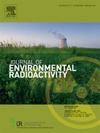韩国Be-7和K-40沉积的环境驱动因素:气象和地质影响的区域分析
IF 2.1
3区 环境科学与生态学
Q3 ENVIRONMENTAL SCIENCES
引用次数: 0
摘要
本研究调查了2014年至2022年韩国15个地点两种天然存在的放射性核素——铍-7 (Be-7)和钾-40 (K-40)的区域行为。利用单因素方差分析和Pearson相关分析,我们评估了气象和地质因素如何影响这些放射性核素的沉积和降雨浓度。Be-7的沉积与降雨、细尘浓度、风速、太阳周期活动密切相关,反映了Be-7的宇宙成因和大气输运敏感性。相比之下,K-40水平更为稳定,与花岗岩分布和海拔高度等地质特征密切相关,对气象的依赖性较弱。空间分析显示,Be-7在春季升高,K-40在冬季升高。岩石环境和降水模式进一步解释了季节和地理趋势。这些发现突出了宇宙和陆地放射性核素的不同环境驱动因素,并支持在环境放射性评估中综合气候和地质变量的重要性。本文提出的方法为解释具有复杂大气或岩性条件的其他地区的放射性核素变异性提供了一个可转移的框架。本文章由计算机程序翻译,如有差异,请以英文原文为准。
Environmental drivers of Be-7 and K-40 deposition in South Korea: A regional analysis of meteorological and geological influences
This study examines the regional behavior of two naturally occurring radionuclides – beryllium-7 (Be-7) and potassium-40 (K-40) – across 15 locations in South Korea from 2014 to 2022. Using one-way ANOVA and Pearson correlation analysis, we evaluated how meteorological and geological factors influence the deposition and rainfall concentrations of these radionuclides. Be-7 deposition showed strong associations with rainfall, fine dust concentration, wind speed, and solar cycle activity, reflecting its cosmogenic origin and atmospheric transport sensitivity. In contrast, K-40 levels were more stable and strongly linked to geological characteristics such as granite distribution and altitude, with weaker meteorological dependence. Spatial analyses revealed distinct regional signatures, with elevated Be-7 in spring and K-40 increasing toward winter. Seasonal and geographic trends were further explained by lithological context and precipitation patterns. These findings highlight the contrasting environmental drivers of cosmogenic and terrestrial radionuclides, and support the importance of integrating climatic and geological variables in environmental radioactivity assessment. The approach presented here provides a transferable framework for interpreting radionuclide variability in other regions with complex atmospheric or lithological conditions.
求助全文
通过发布文献求助,成功后即可免费获取论文全文。
去求助
来源期刊

Journal of environmental radioactivity
环境科学-环境科学
CiteScore
4.70
自引率
13.00%
发文量
209
审稿时长
73 days
期刊介绍:
The Journal of Environmental Radioactivity provides a coherent international forum for publication of original research or review papers on any aspect of the occurrence of radioactivity in natural systems.
Relevant subject areas range from applications of environmental radionuclides as mechanistic or timescale tracers of natural processes to assessments of the radioecological or radiological effects of ambient radioactivity. Papers deal with naturally occurring nuclides or with those created and released by man through nuclear weapons manufacture and testing, energy production, fuel-cycle technology, etc. Reports on radioactivity in the oceans, sediments, rivers, lakes, groundwaters, soils, atmosphere and all divisions of the biosphere are welcomed, but these should not simply be of a monitoring nature unless the data are particularly innovative.
 求助内容:
求助内容: 应助结果提醒方式:
应助结果提醒方式:


